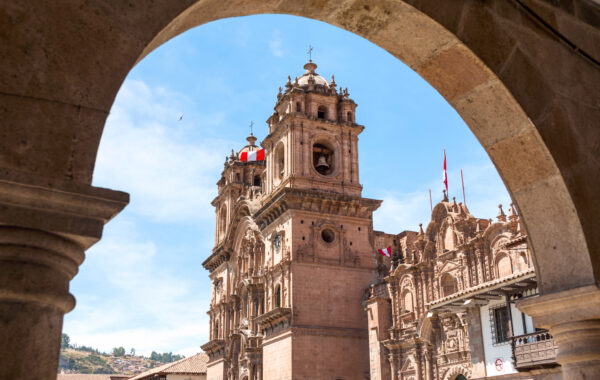Machu Picchu & Amazon lodge
See Peru from rainforest eco-lodge to mountain empires
Combine Peru's two finest gems in one trip: the biodiverse wonderland of Puerto Maldonado in the southern Amazon basin, and the incredible cultural heritage of Machu Picchu and the Sacred Valley. Start your trip in Lima before heading to a remote jungle lodge to explore the rainforest with expert guides, before arriving up into the high Andes to marvel at Machu Picchu, historical Cusco and the many ruins of the beautiful Sacred Valley.
Key information
| Destinations | Lima, Cusco, Sacred Valley, Machu Picchu, Puerto Maldonado, Peruvian Amazon |
|---|---|
| Activity | Luxury, Family, Nature & Wildlife, Culture |
| Physical Level | Mild |
| January - December |
Suggested itinerary

Arrival to Lima
Day 1 in Lima
Depending on your flight arrival time you'll either stay at a nearby airport hotel or, time permitting, transfer to the modern Miraflores district to see some more of the city.

Into the jungle
Day 2–4 in Peruvian Amazon
Take an internal flight to Puerto Maldonado where you'll travel by boat to your jungle lodge deep in the Amazon rainforest. Spend at least three days here on guided nature-spotting excursions, bird watching, hiking, and kayaking.
Don't miss

Visit a luxury Amazon eco-lodge
Puerto Maldonado in Peru’s southern Amazon basin is a wildlife wonderland. Spend a few nights in a full-service jungle lodge and take guided excursions birdwatching, climbing canopy walkways, hiking and canoeing.

Capital of the Inca
Day 5–6 in Cusco
Once the capital of the mighty Inca Empire, Cusco is today the beating heart of Peru's tourism industry. Millions of tourists arrive each year en route to Machu Picchu and the Sacred Valley, and most stay at least a few days in Cusco. With layers of archaeology built on top of each other (often literally), the city is a stunning mix of Inca architecture and later colonial constructions. Packed with excellent restaurants serving both traditional and international cuisine, as well as hostels and hotels for every budget, Cusco has something for everyone.
Some of the most important Inca sites lie within or just outside the city. The most revered temple in the Inca Empire, the Qurikancha (or Coricancha), sits in the historic centre, a short walk from the lively Plaza de Armas with its seemingly endless parades and traditional activities. And overlooking the city is Saksaywaman, a huge complex with some of the most impressive Inca stonework you’ll see, its massive carved blocks interlinking with incredible precision. Then there are the colourful markets of Cusco, where locals sell fresh produce and intricate crafts brought in from across the region, just as they did back in the days of the Inca Empire.
Don't miss

Explore historic Cusco
Cusco, once the capital of the Inca Empire, combines pre-Colombian heritage with colonial-era architecture and vibrant contemporary city life. You can (and should) spend some time exploring solo, but a good quality guided tour will visit the popular sites of Sacsayhuaman, Koricancha and Cusco Cathedral, while avoiding the tourist traps and giving you an insight into the stories behind this fascinating city.

Tour the Sacred Valley
Day 7 in Sacred Valley
The Urubamba River descends from Cusco, eventually connecting with tributaries of the mighty Amazon. Over immense periods of time, this river has carved out a deep valley whose beauty defies the imagination. Little wonder then that the Inca chose this stunning and fertile location as their spiritual and agricultural heartland. Scattered with ruins, towns and villages where Quechua is still commonly heard, the Sacred Valley is much more than a mere stop-off before Machu Picchu. It’s a destination in its own right, and one that is easily explored from Cusco or by staying in the valley itself.
Standout attractions in the Sacred Valley include the Inca citadels of Pisac and Ollantaytambo, and the towns that sit beneath them. Here you’ll find traditional markets selling beautiful textiles and handicrafts made by the locals. Two other popular sites, located in close proximity to each other, are Maras and Moray. Moray features a series of terraced circular depressions, used by the Inca for crop experimentation at different altitudes and microclimates. Maras, meanwhile, is home to thousands of salt evaporation ponds that have been in use since Inca times. In more recent years, the Sacred Valley has become a destination for trekking, rafting, rock climbing and paragliding.
Don't miss

Take a private tour of the Sacred Valley
The glorious Sacred Valley connects Cusco with Machu Picchu and is dotted with ruins, agricultural terraces, and historical towns, including Ollantaytambo, Pisac, Moras, Moray, as well as many lesser-visited spots. Get under the surface with a full-day private tour and explore the ruins, villages and bustling markets, all set amidst incredible landscapes.

Meet Andean culture in the Sacred Valley
Despite the Spanish colonial influence, Peruvian indigenous culture thrives in the Sacred Valley. The village of Ollantaytambo has been inhabited since the 13th century, and nearby Pisac has a vibrant (if somewhat touristy) market. A good guide will help you branch off the tourist trail for a better perspective.

Magical Machu Picchu
Day 8 in Machu Picchu
Machu Picchu is the top attraction in Peru and, in 2007, was voted one of the New Seven Wonders of the World. More than 1.5 million tourists visit Machu Picchu each year, and for good reason. It’s an archaeological gem and one of the finest examples of Inca architecture, stonework and planning. Adding to that is the citadel’s breath-taking location atop a lush mountain ridge, between the two peaks of Machu Picchu Mountain and Huayna Picchu, with the steep sides of the mountain plunging down into the misty river valleys below.
The most famous route to Machu Picchu is the classic Inca Trail, a four-day trek through the mountains, cloud forest and alpine tundra. Alternative treks have become increasingly popular over the last decade or so, and trails like Lares and Salkantay offer different experiences, both geographically and culturally, to the classic trail. Or you can take the train to Aguas Calientes, the lively town below Machu Picchu, and from there a short bus ride up a zigzagging road to the Inca citadel.
Don't miss

Take a guided visit of Machu Picchu
Yes it’s famous and busy, but for a perfectly valid reason: Machu Picchu remains one of the world’s preeminent archaeological sites. In spite of the crowds, an expert guide will bring the place to life and help you make sense of the Inca’s incredible ingenuity. You’ll have the option of climbing the adjacent Huayna Picchu for spectacular views, and can return for a second day exploring if you wish.

Huayna Picchu day hike
- Difficulty: Moderate
- Duration: Two to four hours
- Max elevation: 2,693
- Start/end point: The trailhead is at the far end of the Machu Picchu citadel
The classic Machu Picchu day hike, Huayna Picchu is best known as the perfectly triangular peak that towers behind Machu Picchu in all the classic photos.
Many of the breathtaking photos you’ve seen that are taken from a vantage point far above the ruins were shot from this peak.
Huayna means young in Quechua, as opposed to “machu” which means old. Huayna Picchu is the smaller of the two peaks that bookend the main archeological site and Machu Picchu Mountain is the larger one.
Before committing to this hike, it’s important to know that it is definitely not for people who have a fear of heights. While this can be an issue anywhere in the Andes, climbing Huayna Picchu involves plenty of narrow paths with exposure to sheer drop-offs. There are handrails in the worst spots, but not everywhere you may want them.
Although there are some ruins toward the top, the main reason people do this hike is for the great perspective it gives you, looking down on Machu Picchu. If you are more adventurous, you can also go over the top and around the other side. This will allow you to visit the Temple of the Moon and the Great Cavern.
As with so many hikes in Peru, the hard part isn’t the distance as such, it’s the vertical gain over a very short distance that makes the route so challenging. Be prepared for over 300m (1,000 ft) of ascent, with steep rock stairways all the way up. It takes most people between one and two hours. If you choose to do the hike around to the back as well, you should give yourself a good four hours to complete the circuit and have time to explore the cave.

Departure from Lima
Day 9 in Lima
Return to Lima to meet your flight home or, better still, stay a few days longer and get underneath the skin of Peru's fascinating capital city.
Don't miss

Eat like a king in Lima
Lima’s chefs cook up a storm with the fruits of the sea, mountains and jungle. But it’s not all fine dining and exclusive restaurants: Peru’s is an egalitarian cuisine and you’ll find excellent food at street stalls, local markets and neighbourhood cantinas.

Explore Lima's arts scene
Frequently seen as little more than a transit hub for Machu Picchu, Lima is in fact one of Latin America's great cities. World-leading gastronomy jostles with a flourishing arts scene, easily filling several days of deep cultural immersion.
Where to stay
Classic
Posada Amazonas
Located on a 2,000 hectare private communal reserve and owned by the local community of Infierno, Posada Amazonas provides a great introduction to the Amazon rainforest. The lodge was built using traditional materials and architecture, featuring open windows to the jungle and drapes as doorways. At just 2 hours from the airport in Puerto Maldonado, Posadas Amazonas is ideal for those with limited time to spend in the jungle.
Deluxe
Reserva Amazonica
This eco-luxury lodge is exotic yet accessible, situated in a private reserve surrounded by vast jungle canopy. Inspired by native Amazon design, the lodge is composed of thatched roof cabanas that combine local natural materials with contemporary amenities.
Classic
Casa San Blas
Right off the main pedestrian fare in the San Blas district and less than three blocks to the main square, Casa San Blas Boutique offers exceptional location and comfort. Inside, the well-appointed rooms make for a great night's rest, and the family-style suites are perfect for families.
Superior
Isla Suasi
A luxurious eco-lodge located on the only private island in Lake Titicaca. Lodging includes all food and beverages and the opportunity for activities on the lake. The 24 rustic and appealing rooms all have expansive views of Lake Titicaca as does lunch, which is served on the bluff overlooking the lake.
Deluxe
Machu Picchu Pueblo
Hidden in 12 acres of seclusion, the Pueblo Hotel provides a paradise of individual bungalows with stone paths leading you through the gardens and natural fountains. The Pueblo is laid out in the traditional Andean Village style and consists of 85 luxury cottages, a naturalist centre, a natural Andean sauna, and an exquisite restaurant that overlooks the Vilcanota river below.
Book this itinerary
This route booked with one of our specialist tour operators would cost from $2,990pp. Pricing varies by accommodation class, and can be tailored to suit your budget.
Pricing is typically inclusive of hotels, transfers, meals, and all guided excursions and activities.
Other itineraries you might like

Classic Peru & Machu Picchu
The classic route to Peru's most popular highlights
Approx. 6 days
Machu Picchu & Amazon cruise
Small-ship luxury cruise with Machu Picchu
Approx. 9 days























